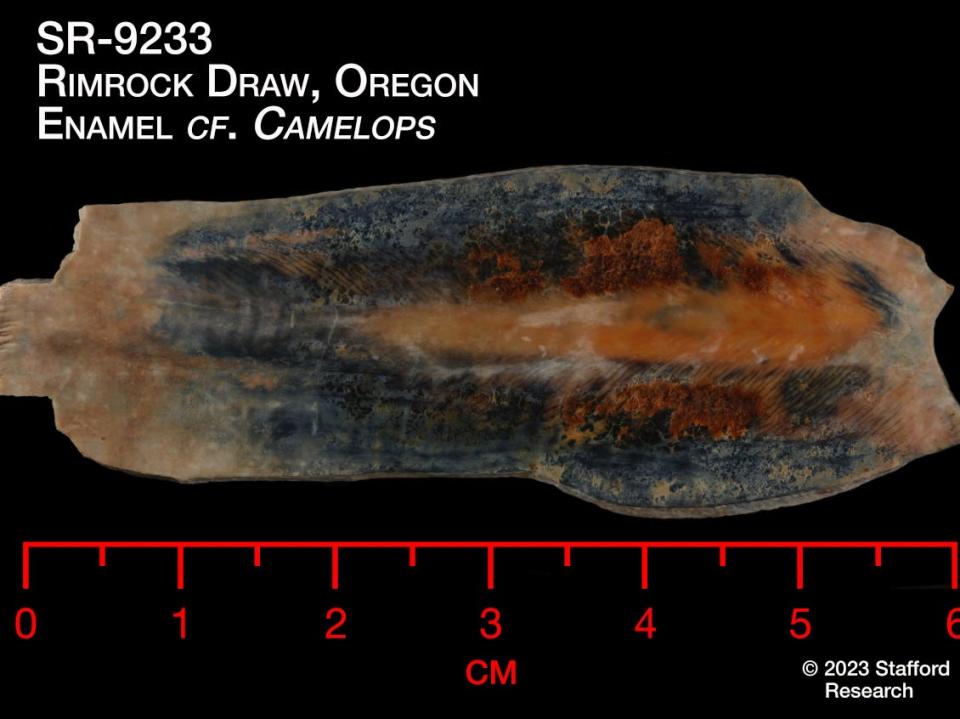18,000-year-old stone tools are among the oldest found in the US, more evidence that humans lived in the Americas during the Ice Age
Archaeologists found stone tools humans used to butcher animals in what's now Oregon.
The tools were below ancient camel and bison tooth fragments that were over 18,000 years old.
It's among the earliest evidence of human occupation in the US.
Ancient hunters used a rock-shelter in the Oregon desert to butcher camels, bison, mountain sheep, and horses during the Ice Age.
In 2012 and 2015, archeologists found blood-stained stone tools buried below teeth from the extinct animals. Recent testing dates the teeth to over 18,000 years old, and the tools could be even older, providing evidence of some of the earliest human occupants in the US.
"Ultimately, we think that the site was occupied for somewhere around 11,000 years, between about 7,000 and 18,000 years ago," Patrick O'Grady, staff archaeologist with the University of Oregon Museum of Natural and Cultural History, told Insider.
The stone tools were below fragments of animal teeth, and both were covered by volcanic ash. The ash landed after Mount St. Helens erupted over 15,000 years ago.
The teeth belonged to a Camelops and bison relative, both extinct for about 10,000 years. Radiocarbon dating revealed the tooth enamel to be 18,250 years old.
Now that they know how old the teeth are, O'Grady and the team plan to publish the findings in a peer-reviewed study.
Since the tools were below the teeth, the researchers estimate they're at least as old, or older, than the 18,250-year-old teeth. It's basically like if you were to try and date the laundry in your laundry basket for the week, O'Grady said.
The clothes you tossed in on Monday will sit below whatever you tossed in on Thursday, as long as no one's dug through it already (or, in the case of archaeological finds, as long as there wasn't a geological shakeup.)
A Stone Age Swiss Army knife
Both tools are made of orange chalcedony, a type of quartz. "It's a really high-quality tool stone," O'Grady said.
Right away, O'Grady and his colleagues were surprised to find that type of stone. "It didn't look familiar to anybody," he said. They determined the stone's place of origin was at least 50 to 75 miles away.

The tool they found in 2012 is a bit smaller than the size of a wallet with a rounded, rectangular shape.
"It had three edges that had different kinds of flaking done to them," O'Grady said, a curved blade, a flatter side, and sawtooth edge.
"You could easily hold the thing and use all three of those different functioning edges," O'Grady said, like a multi-purpose tool or Swiss Army knife.
The other tool is also orange chalcedony and is about 3 inches long and appears to be only lightly used. It may be a chipped-off piece of another tool.
Bison blood and camel teeth
The researchers tested the multi-tool and found bison blood on it. Newer tools researchers found at the site contained remnants of mountain sheep and horse blood.
The blood and many camel and bison teeth fragments suggest people used the site as a place to butcher animals instead of as a full-time residence.
"It was a camp that people came to from time to time, and especially when they were hunting," O'Grady said.

The Rimrock Draw Rockshelter, where the tools were found, is a 65-foot cleft in a basalt rim near an ancient, now-dry stream. There could be more-permanent dwellings in the area archaeologists have yet to find.
The oldest evidence of humans in the US
For decades, experts believed the Clovis people were the first humans in North America, having crossed the Bering land bridge from Siberia to Canada 13,000 years ago. But recent discoveries have indicated a pre-Clovis culture that's thousands of years older.
Oregon and surrounding states contain some of the oldest evidence of ancient human habitation in the US. Coopers Ferry, in Idaho, is about 240 miles to the northeast of Rimrock Draw. Its storage pits and evidence of animal consumption date to about 16,000 years ago. Paisley Cave, about 75 miles away from Rimrock, has 14,400-year-old preserved human excrement.
There's still a lot to learn about how humans arrived and dispersed throughout North and South America. "We just don't have a lot of evidence going back that far in time," O'Grady said. But he thinks it's only a matter of time before someone finds even older evidence of human occupation.
"It's a very exciting time to be doing archaeology," he said, "having one site that's pretty old right now and could be superseded by another one in no time at all."
Read the original article on Business Insider


